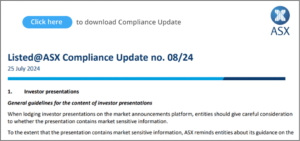GILES RAFFERTY, Corporate Communications and Media Advisor
The ASX has issued a reminder to listed companies to make sure to highlight the presence of new market sensitive information in investor presentations. At a minimum a company should call out the presence of this information in the header of the presentation or, better still, issue a standalone ASX release.
The market watchdog also used the 25 July 2024 compliance update to remind companies it takes a dim view of media releases that are “really promotional, political or tendentious in nature” being posted on the ASX market announcements platform. The ASX also restated that the content of a market release should be factual, relevant and expressed in a clear and o bjective manner and warned against “emotive, intemperate or defamatory language” and the use of woolly expressions such as “double digit”, which do not allow investors to assess the value of information.
bjective manner and warned against “emotive, intemperate or defamatory language” and the use of woolly expressions such as “double digit”, which do not allow investors to assess the value of information.
Enforcement Action
If ASX believes an announcement falls short of its requirements it may take action including:
-
- rejecting the announcement,
- requiring a retraction or correction, and
- suspend trading in the entity’s securities until corrective action is taken by the entity.
Listing Rule 17.3.2 provides that ASX may at any time suspend an entity’s securities to prevent a disorderly or uninformed market. Two specific situations were cited where it will use this power.
Suspension of trading
ASX may choose to suspend trading in a Company’s securities when an entity has requested a trading halt but has nothing material to announce.
If an entity is granted a trading halt pending the release of an announcement, the expectation is the announcement will contain market sensitive information.
Should it be the case that:
-
- an announcement provided to lift the trading halt is plainly not market sensitive; or
- a company enters a trading halt without anything market sensitive to announce; or
- an announcement suitable for release is not provided in time to lift the trading halt,
the ASX’s usual approach will be to suspend quotation of an entity’s securities to prevent a disorderly or uninformed market on the basis that the market was expecting a market sensitive announcement.
Trading in an entity’s securities will not usually resume until an appropriate announcement, including a short account of why there was an absence of market sensitive news, has been released, unless there is some other reason for the suspension to remain in place.
Price query letter
A price query letter is generally issued by ASX when it detects abnormal trading and a listed entity responds that it is not aware of any information, which has not already been announced to the market, which could explain the abnormal trading.
Usually, a company has two hours to respond to a price query letter in order to prevent a disorderly or uninformed market from emerging. In the absence of a timely and or adequate response to a price query ASX’s approach is to suspend quotation of the entity’s securities.
Trading in the entity’s securities will typically resume once the price query letter and an adequate response have been published on the market announcements platform, unless there is some other reason for the entity’s securities to remain suspended.
Mining Company Disclosures
ASX has given mining companies advance warning that it intends to scrutinise their presentation materials this year. Examples of where they will be focusing their attention include:
-
- new or materially changed information should have already been released in a stand-alone announcement before appearing in a presentation
- any estimates or targets must be accompanied by cautionary statements and should be on the same page and in the same paragraph….. They should also be given equal prominence, which means being in the same font type, size and colour as the relevant information.
- Where a listed entity discloses an objectionable peer comparison ASX may require the entity to publish an announcement withdrawing or retracting the objectionable material.
- Mining entities must not disclose market sensitive information on social media platforms prior to disclosing that information through the market announcements platform. ASX has recently caused entities to remove inappropriate visual results, in-ground values and peer comparisons from social media platforms.
The 25 July 2024 ASX compliance update can be downloaded by clicking here.